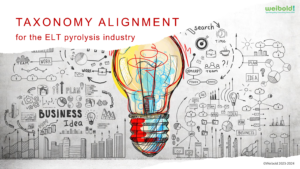Taxonomy: Why Invest in ELT-Pyrolysis Projects?
In 2019, the European Union (EU) began a transformative journey towards a sustainable future with the adoption of the Green Deal.
This ambitious plan aims to drive investment in renewable energy, biodiversity, and circular economy initiatives, to achieve a climate-neutral EU economy by 2050, with a 55 percent reduction in emissions by 2030.
Achieving these goals requires a significant investment of 1 trillion euros planned over the next decade. Despite this commitment, the EU recognizes the central role of the private sector in delivering on the Paris Climate Agreement.
To pave the way for friction-free trade and ensure fair competition, legal clarity, and alignment with sustainability goals, the EU issued the Taxonomy Regulation and the Sustainable Finance Disclosure Regulation (SFDR).
These regulations focus on directing capital into sustainable investments, incentivizing private investment in green projects, integrating sustainability into risk management, and promoting long-term economic activity.
The Taxonomy Regulation focuses on six environmental objectives: climate change mitigation and adaptation, sustainable use of water and marine resources, transition to a circular economy, pollution prevention and control, and protection and restoration of biodiversity and ecosystems.
The overarching objectives of the Taxonomy Regulation aim to transition to a low-carbon, sustainable, resource-efficient circular economy in line with the Sustainable Development Goals (SDGs).
It creates a uniform classification system within the EU and provides clarity about which activities are considered “sustainable”.
 Financial market participants, including investment funds, must disclose the proportion of environmentally sustainable investments in their portfolios. Likewise, companies subject to non-financial reporting under the CSR Directive must provide information about environmentally sustainable activities. Disclosures include EU taxonomy-compliant revenue shares, capital expenditure (CapEx), and operating expenses (OpEx).
Financial market participants, including investment funds, must disclose the proportion of environmentally sustainable investments in their portfolios. Likewise, companies subject to non-financial reporting under the CSR Directive must provide information about environmentally sustainable activities. Disclosures include EU taxonomy-compliant revenue shares, capital expenditure (CapEx), and operating expenses (OpEx).
While chemical recycling (pyrolysis) operations of end-of-life tires (ELT) strongly contribute to the EU Taxonomy objectives by recovering materials from non-hazardous waste and producing carbon black (rCB) and organic chemicals (biogenic fraction of TPO), they do not harm any of the six environmental objectives. Furthermore, the Turnover KPI of an ELT pyrolysis operation aligns up to 100 percent, with the Taxonomy while the CapEx and OpEx align at 75 percent to 85 percent (depending on the project).
The EU taxonomy offers significant benefits to companies aligning key performance indicators with their policies. Benefits include increased investor attractiveness, portfolio transparency, access to green financing, improved risk management, and positioning them ahead of regulatory changes and market trends in the transition to a low-carbon economy.
The ELT pyrolysis industry can prove that it is fully aligned with the EU Taxonomy and therefore, in addition to the fact that it is a valuable supplier of sustainable and economically profitable secondary raw materials, companies, and financial institutions affected by the Taxonomy regulation should look creatively at investing in this emerging industry.
© Scrap Tire News, January 2024






